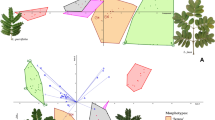Abstract
Field collections and 296 herbarium sheets were examined for 27 morphometric variables. A priori species identifcation was based on geographical distribution except forH. californicum, a diploid species primarily occurring in California and differing from the much more widespread tetraploidH. brachyantherum that thrives in N. America and N.E. Asia;H. capense grows in S. Africa andH. secalinum mainly in Europe. Various cluster analyses were used followed by cluster recovery verification. Classificatory discriminant analysis and validation by the bootstrap yielded 85–90% overall total correct classification of the four species. Canonical analysis revealed thatH. californicum occupies an intermediate phenetic position among the other three distinct species. Factors of shape differences were unravelled and portrayed by shearing. A revised key to species was drawn up.
Similar content being viewed by others
References
Baum, B. R., Bailey, L. G., 1989: AreHordeum brachyantherum andH. californicum (Triticeae: Poaceae) conspecific? — Canad. J. Bot. (in press).
—, 1984: Barley gene pool. A collection maintained by Agriculture Canada and by the Danish and Swedish agricultural universities (Nordic Gene Bank). Canadian-ScandinavianHordeum Collection (CHC). — Cat. No. 1761/B, Supply and Services Canada, Ottawa.
Bookstein, F. L., Chernoff, B., Elder, R. L., Humphries, Jr.,J. M., Smith, G. R., Strauss, R. E., 1985: Morphometrics in evolutionary biology. — Academy of Sciences Philadelphia: Special Publ.15.
Bothmer, R. von, 1979: Revision of the Asiatic taxa ofHordeum sect.Stenostachys. — Bot. Tidsskr.74: 17–146.
—, 1979: A taxonomic revision ofHordeum secalinum andH. capense. — Bot. Tidsskr.74: 223–235.
—, 1985: Origin, taxonomy, and related species. — InRasmusson, D. C., (Ed.): Barley agronomy monography26, pp 19–56. — Madison, WI.: ASA-CSSA-SSSA.
—, 1986: Interspecific crosses inHordeum (Poaceae). — Pl. Syst. Evol.153: 49–64.
Cooley, W. W., Lohnes, P. R., 1971: Multivariate data analysis. — New York: Wiley.
Covas, G., 1949: Taxonomic observations on the North American species ofHordeum. — Madroño10: 1–21.
Efron, B., Gong, G., 1983: A leisurely look at the bootstrap, the jacknife, and cross-validation. — Amer. Stat.37: 36–48.
Everitt, B. S., 1980: Cluster analysis. 2nd edn. — London: Heineman.
Gower, J. C., 1967: A comparison of some methods of cluster analysis. — Biometrics23: 623–637.
—, 1971: A general coefficient of similarity and some of its properties. — Biometrics27: 857–871.
Hitchcock, A. S., 1951: Manual of grasses of the United States. 2nd edn. revised byA. Chase. — Washington, D.C.: U.S.D.A. Miscell. Publ.200.
Holmgreen, P. P., Keuken, W., Schofield, E. K., 1981: Index herbariorum, 1. The herbaria of the world. — Utrecht: Bohn, Scheltema & Holkema.
Humphries, C. J., 1980:Hordeum L. — InTutin, T. G. & al., (Eds.): Flora Europaea5, pp. 204–205. — Cambridge: Cambridge University Press.
Jorgensen, R. B., 1986: Relationships in the barley genus (Hordeum): an electrophoretic examination of proteins. — Hereditas104: 273–291.
Klecka, W. R., 1980: Discriminant analysis. Sage University Paper series on Quantitative Applications in Social Sciences, series n. 07-019. — Beverly Hills: Sage Publications.
Lance, G. N., Williams, W. T., 1967: A general theory of classificatory sorting strategies. 1. Hierarchical systems. — Computer J.9: 373–380.
Linde-Laursen, I., von Bothmer, R., Jacobsen, N., 1986: Giemsa C-banded karyotypes ofHordeum secalinum, H. capense ant their interspecific hybrids withH. vulgare. — Hereditas105: 179–185.
Milligan, G. W., 1980: An examination of the effect of six types of error perturbation on 15 clustering algorithms. — Psychometrika44: 343–346.
Munz, P. A., 1974: A flora of southern California. — Berkeley: University of California Press.
Nevski, S. A., 1941: Beiträge zur Kenntnis der wildwachsenden Gersten in Zusammenhang mit der Frage über den Ursprung vonHordeum vulgare 1. undHordeum distichon L. (Versuch einer Monographie der GattungHordeum). — Trudy Bot. Inst. Akad. Nauk S.S.S.R., ser. 1,5: 64–255.
Rao, R. C., 1973: Linear statistical inference and its applications. — New York: Wiley.
SAS Institute Inc. 1985a: SAS® user's guide: basics, version 5 edition. — Cary, NC: SAS Institute Inc.
SAS Institute Inc. 1985b: SAS® user's guide: statistics, version 5 edition. — Cary, NC: SAS Institute Inc.
Sarle, W. S., 1986: The MODECLUS procedure. Preliminary documentation. — Cary, NC: SAS Institute, Mimeo.
Sneath, P. H. A., 1957: The application of computers to taxonomy. — J. Gen. Miocrob.17: 201–226.
Sokal, R. R., Michener, C. D., 1958: A statistical method for evaluating systematic relationships. — Univ. Kansas Sci. Bull.38: 1409–1438.
Sorensen, T., 1948: A method of establishing groups of equal amplitude in plant sociology based on similarity of species content and its application to analyses of the vegetation on Danish Commons. — Biol. Skr.5: 1–34.
Tsvelev, N. N., 1976: Grasses of the Soviet Union (Zlaki SSSR.). — Transl. for the Smithsonian Institution Libraries and the National Science Foundation. — New Delhi: Amerind Publishing Co.
Ward, J. H., 1963: Hierarchical grouping to optimize an objective function. — J. Amer. Stat. Assoc.56: 236–244.
Wisenbaker, J. M., Huperty, C. J., 1984: Applying the bootstrap to estimate classification hit rates. — Paper presented at the Annual Meeting of the American Educational Research Association, New Orleans, LA. Mimeo.
Wong, M. A., Lane, T., 1983: A k'th nearest neighbor clustering procedure. — J. Royal Stat. Soc. Ser. B.,45: 362–368.
Author information
Authors and Affiliations
Rights and permissions
About this article
Cite this article
Baum, B.R., Bailey, L.G. Differentiation of fourHordeum sect.Stenostachys spp. (Poaceae: Triticeae) using multivariate morphometrics. Pl Syst Evol 166, 211–223 (1989). https://doi.org/10.1007/BF00935950
Received:
Revised:
Issue Date:
DOI: https://doi.org/10.1007/BF00935950




